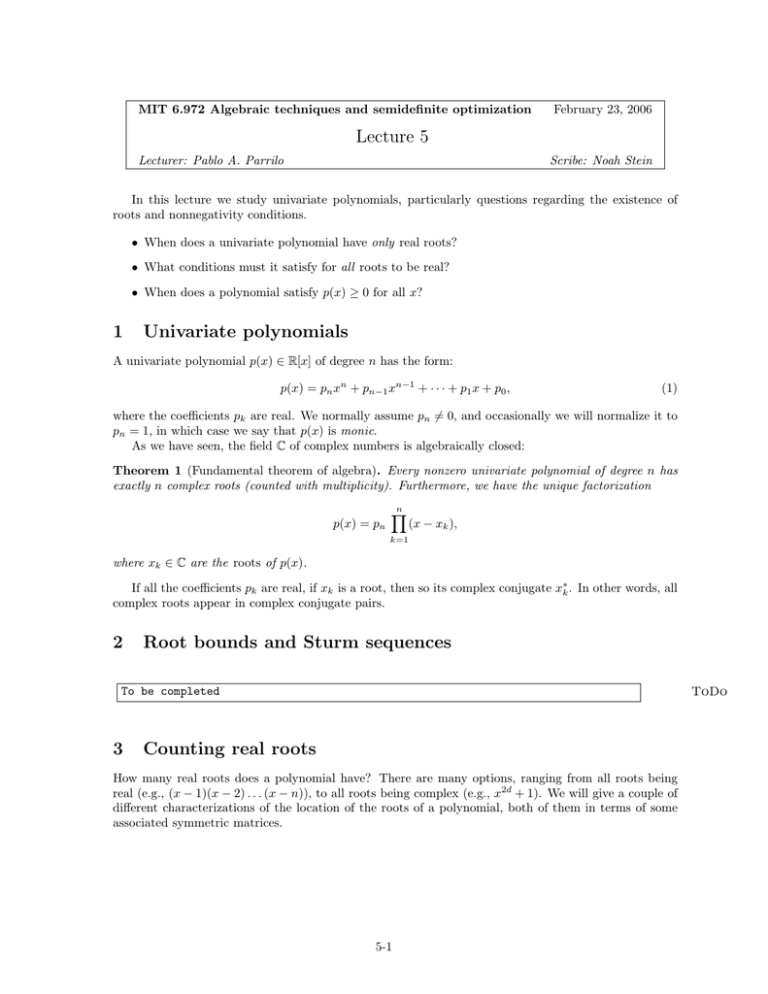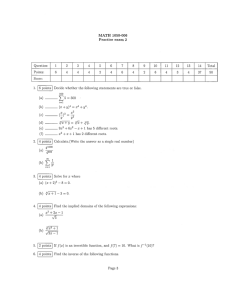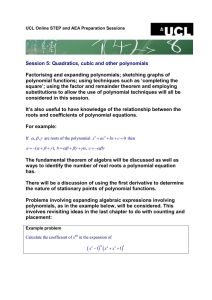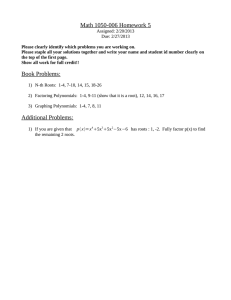Lecture 5
advertisement

MIT 6.972 Algebraic techniques and semidefinite optimization
February 23, 2006
Lecture 5
Lecturer: Pablo A. Parrilo
Scribe: Noah Stein
In this lecture we study univariate polynomials, particularly questions regarding the existence of
roots and nonnegativity conditions.
• When does a univariate polynomial have only real roots?
• What conditions must it satisfy for all roots to be real?
• When does a polynomial satisfy p(x) ≥ 0 for all x?
1
Univariate polynomials
A univariate polynomial p(x) ∈ R[x] of degree n has the form:
p(x) = pn xn + pn−1 xn−1 + · · · + p1 x + p0 ,
(1)
where the coefficients pk are real. We normally assume pn �= 0, and occasionally we will normalize it to
pn = 1, in which case we say that p(x) is monic.
As we have seen, the field C of complex numbers is algebraically closed:
Theorem 1 (Fundamental theorem of algebra). Every nonzero univariate polynomial of degree n has
exactly n complex roots (counted with multiplicity). Furthermore, we have the unique factorization
p(x) = pn
n
�
(x − xk ),
k=1
where xk ∈ C are the roots of p(x).
If all the coefficients pk are real, if xk is a root, then so its complex conjugate x∗k . In other words, all
complex roots appear in complex conjugate pairs.
2
Root bounds and Sturm sequences
To be completed
3
ToDo
Counting real roots
How many real roots does a polynomial have? There are many options, ranging from all roots being
real (e.g., (x − 1)(x − 2) . . . (x − n)), to all roots being complex (e.g., x2d + 1). We will give a couple of
different characterizations of the location of the roots of a polynomial, both of them in terms of some
associated symmetric matrices.
5­1
3.1
The companion matrix
A very well­known relationship between univariate polynomials and matrices is given through the so­
called companion matrix.
Definition 2. The companion matrix Cp associated with the polynomial p(x) in (1) is the n × n real
matrix
⎡
⎤
0 0 ··· 0
−p0 /pn
⎢1 0 · · · 0
−p1 /pn ⎥
⎢
⎥
⎢0 1 · · · 0
−p2 /pn ⎥
Cp := ⎢
⎥.
⎢ .. .. . .
⎥
.
..
⎣. .
⎦
. ..
.
0 0 · · · 1 −pn−1 /pn
Lemma 3. The characteristic polynomial of Cp is (up to a constant) equal to p(x). Formally, det(xI −
Cp ) = p1n p(x).
From this lemma, it directly follows that the eigenvalues of Cp are exactly equal to the roots xi of p(x),
including multiple roots the appropriate number of times. In other words, if we want to obtain the roots
of a polynomial, we can do this by computing instead the eigenvalues of the associated (nonsymmetric)
companion matrix. In fact, that is exactly the way that MATLAB computes roots of polynomials; see
the source file roots.m.
�n
k
For
∈ Cn×n , we always have TrA = i=1 λi (A), and λi (Ak ) = λi (A)
it follows
�nany A
�m. Therefore,
k
k
that i=1 xi = Tr [Cp ]. As a consequence of linearity, we have that if q(x) = j=0 qj xj is a univariate
polynomial,
n
n �
m
m
m
�
�
�
�
j
j
q(xi ) =
qj xi =
qj Tr[Cp ] = Tr[
qj Cpj ] = Tr [q(Cp )],
(2)
i=1
i=1 j=0
j=0
j=0
where the expression q(Cp ) indicates the evaluation of the polynomial q(x) on the companion matrix of
p(x). Note that if p is monic, then the final expression in (2) is a polynomial in the coefficients of p.
This is an identity that we will use several times in the sequel.
Remark 4. Our presentation of the companion matrix has been somewhat unmotivated, other than
noticing that “it just works.” After presenting some additional material on Gröbner basis, we will revisit
this construction, where we will give a natural interpretation of Cp as representing a well­defined linear
operator in the quotient ring R[x]/�p(x)�. This will enable a very appealing generalization of companion
matrices to multivariate polynomials, in the case where the underlying system has only a finite number
of solutions (i.e., a “zero dimensional ideal”).
3.2
Inertia and signature
Definition 5. Consider a symmetric matrix A. The inertia of A, denoted I(A), is the triple (n+ , n0 , n− ),
where n+ , n0 , n− are the number of positive, zero, and negative eigenvalues, respectively. The signature
of A is equal to the number of positive eigenvalues minus the number of negative eigenvalues, i.e., the
integer n+ − n− .
Notice that, with the notation above, the rank of A is equal to n+ + n− . A symmetric positive
definite n × n matrix has inertia (n, 0, 0), while a positive semidefinite one has (n − k, k, 0) for some
k ≥ 0. The inertia is an important invariant of a quadratic form, since it holds that I(A) = I(T T AT ),
where T is nonsingular. This invariance of the inertia of a matrix under congruence transformations is
known as Sylvester’s law of inertia; see for instance [HJ95].
5­2
3.3
The Hermite form
While the companion matrix is quite useful, we will present now a different characterization of the roots
of a polynomial. Among others, an advantage of this formulation is the fact that we will be using
symmetric matrices.
Let q(x) be a fixed auxiliary polynomial. Consider the following n × n symmetric Hankel matrix
Hq (p) with complex entries defined by
[Hq (p)]jk =
n
�
q(xi )xj+k−2
.
i
(3)
i=1
Like every symmetric matrix, Hq (p) defines an associated quadratic form via
⎡
f0
f1
..
.
⎤T ⎡
⎢
⎥
⎢
⎥
f T Hq (p)f = ⎢
⎥
⎣
⎦
fn−1
=
n
�
�n
�ni=1 q(xi )
⎢
i=1 q(xi )xi
⎢
⎢
..
⎣
.
�n
n−1
q(x
i )xi
i=1
�n
�ni=1 q(xi )x2i
i=1 q(xi )xi
..
�n .
n
i=1 q(xi )xi
···
···
..
.
···
⎤
�n
n−1 ⎤ ⎡
f0
i=1 q(xi )xi
�
n
n ⎥⎢
⎥
i=1 q(xi )xi ⎥ ⎢ f1 ⎥
⎥ ⎢ .. ⎥
..
⎦⎣ . ⎦
.
�n
2n−2
fn−1
i=1 q(xi )xi
q(xi )(f0 + f1 xi + · · · + fn−1 xn−1
)2
i
i=1
= Tr[(qf 2 )(Cp )].
Although not immediately obvious from the definition (3), the expression above shows that when p(x)
is monic, the entries of Hq (p) are actually polynomials in the coefficients of p(x). Notice that we have
used (2) in the derivation of the last step.
Define now the n × n Vandermonde matrix
⎡
⎤
1 x1 . . . xn−1
1
⎢1 x2 . . . xn−1 ⎥
2
⎢
⎥
V = ⎢.
.. . .
.. ⎥
.
⎣.
.
.
. ⎦
1 xn
...
xnn−1
where x1 , . . . , xn ∈ C. It can be shown that such a matrix is nonsingular if and only if all the xi are
distinct. Note that a Vandermonde matrix �defines a linear transformation
mapping the coefficients of
�
a degree n − 1 polynomial f to its values f (x1 ), . . . , f (xn ) . Since this transformation is invertible,
given any y ∈ Rn there always exits an f of degree n − 1 such that f (xi ) = yi (i.e., there is always an
interpolating polynomial). From the expressions above, we have the factorization
Hq (p) = V T diag[q(x1 ), . . . , q(xn )] V.
This is almost a congruence transformation, except that there are complex terms if some of the xi are
complex. However, this can be easily resolved, to obtain the theorem below.
Theorem 6. The signature of Hq (p) is equal to the number of real roots xj of p for which q(xj ) > 0,
minus the number of real roots for which q(xj ) < 0.
Proof. For simplicity, we assume all roots are distinct (this is easy to change, at the expense of slightly
5­3
more complicated notation). We have then
f T Hq (p)f =
n
�
q(xj )(f0 + f1 xj + · · · + fn−1 xn−1
)2
j
j=1
=
�
�
q(xj )f (xj )2 + q(x∗j )f (x∗j )2
xj ,x∗
j ∈C\R
xj ∈R
=
�
q(xj )f (xj )2 +
q(xj )f (xj )2 + 2
�
xj ,x∗
j ∈C\R
xj ∈R
�T �
��
�
�
�f (xj )
�q(xj ) −�q(xj ) �f (xj )
.
�f (xj )
−�q(xj ) −�q(xj ) �f (xj )
Notice that an expression of the type f (xi ) is a linear form in [f0 , . . . , fn−1 ]. Because of the assumption
that all the roots xj are distinct, the linear forms {f (xj )}j=1,...,n are linearly independent (the corre­
sponding Vandermonde matrix is nonsingular), and thus so are {f (xj )}xj ∈R ∪ {�f (xj ), �f (xj )}xj ∈C\R .
Therefore, the expression above gives a congruence transformation of Hq (p), and we can obtain its sig­
nature by adding the signatures of the scalar elements q(xj ) and the 2 × 2 blocks. The signature of the
2 × 2 blocks is always zero (they have zero trace), and thus the result follows.
In particular, notice that if we want to count the number of roots, we can just use q(x) = 1. The
matrix corresponding to this quadratic form (called the Hermite form) is:
⎡
⎤
s0
s1 · · · sn−1
n
⎢ s1
�
s2 · · ·
sn ⎥
⎢
⎥
H1 (p) = ⎢ .
,
s
=
xkj .
⎥
.
.
k
..
..
.. ⎦
⎣ ..
.
j=1
sn−1
sn
···
s2n−2
The sk are known as the power sums and can be computed with 2. When p(x) is monic, the sk are
polynomials of degree k in the coefficients of p(x).
Example 7. Consider the monic cubic polynomial
p(x) = x3 + p2 x2 + p1 x + p0 .
Then, the first five power sums are:
s0 = 3
s1 = −p2
s2 = p22 − 2p1
s3 = −p23 + 3p1 p2 − 3p0
s4 = p24 − 4p1 p22 + 2p12 + 4p0 p2 .
Lemma 8. The signature of H1 (p) is equal to the number of real roots. The rank of H1 (p) is equal to
the number of distinct complex roots of p(x).
Corollary 9. If p(x) has odd degree, there is always at least one real root.
Example 10. Consider p(x) = x3 + 2x2 + 3x + 4. The corresponding Hermite matrix is:
⎡
⎤
3 −2 −2
H(p) = ⎣−2 −2 −2⎦
−2 −2 18
This matrix has one negative and two positive eigenvalues, all distinct (i.e., its inertia is (2, 0, 1)). Thus,
p(x) has three simple roots, and exactly one of them is real.
Sylvester’s law of inertia guarantees that this result is actually coordinate independent.
5­4
4
Nonnegativity
An important property of a polynomial is whether it only takes nonnegative values. As we will see, this
is of interest in a wide variety of applications.
Definition 11. A univariate polynomial p(x) is positive semidefinite or nonnegative if p(x) ≥ 0 for all
real values of x.
Clearly, if p(x) is nonnegative, then its degree must be an even number. The set of nonnegative
polynomials has very interesting properties. Perhaps the most appealing one for our purposes is the
following:
Theorem 12. Consider the set Pn of nonnegative univariate polynomials of degree less than or equal
to n (n is even). Then, identifying a polynomial with its n + 1 coefficients (pn , . . . , p0 ), the set Pn is a
proper cone (i.e., closed, convex, pointed, solid) in Rn+1 .
An equivalent condition for the (nonconstant) univariate polynomial (1) to be strictly positive, is
that p(x0 ) > 0 for some x0 , and it that has no real roots. Thus, we can use Theorem 6 to write explicit
conditions for a polynomial p(x) to be nonnegative in terms of the signature of the associated Hermite
matrix H1 (p).
5
Sum of squares
Definition 13. A univariate polynomial p(x) is a sum of squares (SOS) if there exist q1 , . . . , qm ∈ R[x]
such that
m
�
p(x) =
qk2 (x).
k=1
If a polynomial p(x) is a sum of squares, then it obviously satisfies p(x) ≥ 0 for all x ∈ R. Thus, a
SOS condition is a sufficient condition for global nonnegativity.
Interestingly, in the univariate case, the converse is also true:
Theorem 14. A univariate polynomial is nonnegative if and only if it is a sum of squares.
�
Proof. (⇐) Obvious. If p(x) = k qk2 (x) then p(x) ≥ 0.
(⇒) Since p(x) is univariate, we can factorize it as
�
�
p(x) = pn (x − rj )nj
(x − ak + ibk )mk (x − ak − ibk )mk ,
j
k
where rj and ak ± ibk are the real and complex roots, respectively. Because p(x) is nonnegative, then
pn > 0 and the multiplicies of the real roots are even, i.e., nj = 2sj .
Notice that (x − a + ib)(x − a − ib) = (x − a)2 + b2 . Then, we can write
�
��
�mk
p(x) = pn (x − rj )2sj
(x − ak )2 + b2k
,
j
k
Since products of sums of squares are sums of squares, and all the factors in the expression above are
SOS, it follows that p(x) is SOS.
Furthermore, the two­squares identity (α2 + β 2 )(γ 2 + δ 2 ) = (αγ − βδ)2 + (αδ + βγ)2 allows us to
combine every partial product as a sum of only two squares.
Notice that the proof shows that if p(x) is SOS, then there exists a representation p(x) = q12 (x)+q22 (x).
As we will see very soon, we can decide whether a univariate polynomial is a sum of squares (equiv­
alently, if it is nonnegative) by solving a semidefinite optimization problem.
5­5
6
Positive semidefinite matrices
Recall from Lecture 2 the (apparent) disparity between the stated conditions for a matrix to be positive
definite versus the semidefinite case. In the former, we could use a test (Sylvester’s criterion) that
required the calculation of only n minors, while for the semidefinite case apparently we needed a much
larger number, 2n − 1.
If the matrix X is positive definite, Sylvester’s criterion requires the positivity of the leading principal
minors, i.e.,
det(X1,1 ) > 0, det X12,12 > 0, . . . , det X > 0.
For positive semidefiniteness, it is not enough to replace strict positivity with the nonstrict inequality;
a simple counterexample is the matrix
�
�
0 0
,
0 −1
for which the leading minors vanish, but is not PSD. As mentioned, an alternative approach is given by
the following classical result:
Lemma 15. Let A ∈ Rn×n be symmetric. Then A � 0 if and only if all 2n − 1 principal minors of A
are nonnegative.
Although the condition above requires the nonnegativity of 2n − 1 expressions, it is possible to do
the same by checking only n inequalities:
Theorem 16 (e.g. [HJ95, p. 403]). A real n × n symmetric matrix A is positive semidefinite if and only
if all the coefficients ci of its characteristic polynomial p(λ) = det(λI −A) = λn +pn−1 λn−1 +· · · +p1 λ+p0
alternate in sign, i.e., they satisfy pi (−1)n−i ≥ 0.
We prove this below, since we will use a slightly more general version of this result when discussing
hyperbolic polynomials. Note that in the n = 2 case Theorem 16 is the familiar result that A is positive
semidefinite if and only if det A ≥ 0 and TrA ≥ 0.
�n−1
Lemma 17. Consider a monic univariate polynomial p(t) = tn + k=0 pk tk , that has only real roots.
Then, all roots are nonpositive if and only if all coefficients are nonnegative (i.e., pk ≥ 0, k = 0, . . . , n−1).
Proof. Since all roots of p(t) are real, this can be obtained from a direct application of Descartes’ rules
of signs; see e.g. [BPR03]. For completeness, we present here a direct proof.
If all roots ti are nonpositive (ti ≤ 0), from the factorization
p(t) =
n
�
(t − ti )
k=1
it follows directly that all coefficients pk are nonnegative.
For the other direction, from the nonnegativity of the coefficients it follows that p(0) ≥ 0 and p(t)
is nondecreasing. If there exists a ti > 0 such that p(ti ) = 0, then the polynomial must vanish in the
interval [0, ti ], which is impossible since it is monic and hence nonzero.
Definition 18. A set S ⊂ Rn is basic closed semialgebraic if it can be written as
S = {x ∈ Rn | fi (x) ≥ 0,
hj (x) = 0}
for some finite number of polynomials fi , hj .
Theorem 19. Both the primal and dual feasible sets of a semidefinite program are basic closed semial­
gebraic.
5­6
Proof. The condition X � 0 is equivalent to n nonstrict polynomial inequalities in the entries of X. This
can be conveniently shown applying Lemma 17 to the characteristic polynomial of −X, i.e.,
p(λ) = det(λI + X) = λn +
n−1
�
pk (X)λk .
k=0
where the pk (X) are homogeneous polynomials of degree n − k in the entries of X. For instance, we
have p0 (X) = det X, and pn−1 (X) = TrX.
Since X is symmetric, all its eigenvalues are real, and thus p(λ) has only real roots. Positive semidef­
initeness of X is equivalent to p(λ) having no roots that are strictly positive. It then follows than the
two following statements are equivalent:
X�0
⇔
pk (X) ≥ 0 k = 0, . . . , n − 1.
Remark 20. These inequalities correspond to the elementary symmetric functions ek evaluated at the
eigenvalues of the matrix X.
As we will see in subsequent lectures, the same inequalities will reappear when we consider a class
of optimization problems known as hyperbolic programs.
References
[BPR03] S. Basu, R. Pollack, and M.­F. Roy. Algorithms in real algebraic geometry, volume 10 of
Algorithms and Computation in Mathematics. Springer­Verlag, Berlin, 2003.
[HJ95]
R. A. Horn and C. R. Johnson. Matrix Analysis. Cambridge University Press, Cambridge,
1995.
5­7








